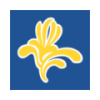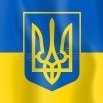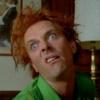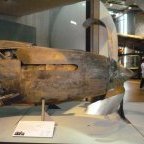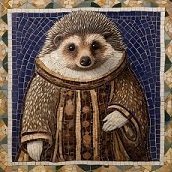Search the Community
Showing results for tags 'Focke-Wulf'.
-
Zoukei Mura is developing a series of 1/32nd Focke-Wulf Fw.190A & Fw.190D kits. Source: https://www.facebook.com/cybermodeller?hc_location=timeline V.P.
- 63 replies
-
- Fw.190
- Focke-Wulf
-
(and 1 more)
Tagged with:
-
Greetings everyone. If possible, I would like some help from my friends on the forum. I'm building a Ta-152 in 1/32 scale from Zouke-Mura, although the kit is good, I would like to improve it. Unfortunately or fortunately, I am one of the fans of using rivets. I'm looking for images that can help with applying the rivets. The biggest reference I could have is the edition of the book about the Ta-152 made by the publisher KAGERO. It will take a while until I get the book. Anyone who can help, I would be immensely grateful. Cheers from Brazil.
- 21 replies
-
- Ta152H
- focke-wulf
-
(and 1 more)
Tagged with:
-
Thanks Pin! Pepelatz is to release a 1/72nd Focke-Wulf P.281 resin kit - ref. PPZ7206 Source: https://www.facebook.com/pepelatzmodels/posts/1334533360252276 Box art & 3D renders V.P.
- 1 reply
-
- 2
-

-
- Pepelatz
- Focke-Wulf
-
(and 1 more)
Tagged with:
-
Ok this is part two of a new project that I have sort of been hinting about and the base components have been photo bombing. Again I blame Arnold for this rash of “unusual” builds. Basically this is a “what shall I do with the left-overs” build, but after having a look at what will be involved a far more substantial build than the Arado one. One of the big issues was to the layout of the undercarriage and to where to fit it! With the two engine pods for the BWM’s there is no room for undercarriage. I could have gone with something exotic like a bicycle mains with outriggers but that does suit the look I’m after. But I now have a cunning plan that will be revealed a bit further down. Ok a bit of a mock-up to see what it will look like, it’s workable and a bit odd. It will be an all metal body so a whole lot of new panel lines will need to be done…oh what fun that’ll be!!! So first off the wing, this will be the whole wing and engines leftover from the turbo-Prop build. Like the Jumo Arado the wing actually sort of fits the fuselage, which will make stitching this together a lot easier. I’ve cut the Arado’s wing to suit the wing cut out of the 154, this gives me the correct (?) position for the new wing. I’ll need some packing to get the wing to sit at the right height. With it all together now (well held together by tape anyway) I can new get a good idea of how she will look. I will use the tail plug for the 154-A2 mod kit. The nose is still quite stubby but I am thinking about extending time a wee bit from behind where the RO sits, maybe enough to have the pilot level or just in front of the intakes. Plus I will not be using the FuG-220 antenna array, instead I will use the extra resin FuG-240 “dustbin” I had from the Arado P5 build. Seeing this is a Luft46 aircraft it’ll need a more modern radar! I don’t have any photos to show but it is the perfect size an looks amazing! Ok now for the main gear, after lots of thinking and looking in the spares box I ended up coming back the Arados main gear. With very little moding of the gear bay it fits perfectly! So some quick marking up using the Arado as a guide and one hole later we have it! Looks pretty sweet and are in a similar position to the Arados. So this is a doable project, a bit more complex than her sister, plus she will have a new resin cockpit. Most of the work will be getting the wings to fit and on, plus re-profiling. This won’t be a quick project at all, this one will take time but should be lots of fun as well. TrickyRich Aviation Werks is now in full production mode!! Business logo on the way!
- 14 replies
-
- 5
-

-
- Ta-154
- Focke-Wulf
-
(and 1 more)
Tagged with:
-
I really like these early Luftwaffe flying boats, so when this one appeared on evil bay I couldn't resist it. Really nicely moulded parts. Having never built a Planet kit before I'm looking forward to this one. Cheers Pat
- 10 replies
-
- 12
-

-
- Planet Models
- Focke-Wulf
-
(and 1 more)
Tagged with:
-
Dragon's Fw 190D-9 has been replaced by the Hobby Boss kit, a much superior offering with much better fit all around. I had bought Dragon's kit in order to have Gerhard Barkhorn's decals. The kit itself has many moulding defects, big gaps around the fuselage/wing section (which is solved by adding a spreader bar aft the cockpit), the propeller blades don´t have locating tabs, the aircraft sits too high on its gear because of a manufacturer idea, it comes with steel PE parts which are nigh impossible to cut from their sprue with a regular hobby knife, etc... I decided to paint the model as Oskar Romm's aircraft, which in reality had the old Fw 190 canopy instead of the blown one. The model was brushpainted with what I thought were the Revell equivalents of RLM 82 and RLM 83 (Bronze Green 65 and RAF Dark Green 68).
- 4 replies
-
- 9
-

-
- Focke-Wulf
- FW 190D-9
-
(and 1 more)
Tagged with:
-
Airframe Detail Number 6 – Ta.154 Moskito Valiant Wings Publishing Kurt Tank was a gifted engineer and created a number of successful designs for the German war effort during WWII, with the Moskito being one of his less successful due in part to circumstances beyond his control. The original design was intended to use the least strategic materials as possible, and the fuselage and wings were instead constructed mainly from laminated wood that was bonded by a phenolic resin for strength. The prototype was flown in competition with two other designs and achieved a very high maximum speed, but it was unarmed and had no military equipment fitted at that stage. When it finally flew with this in place, it slowed the aircraft appreciably by as much as 75km/h (47mph), which eroded its advantage over the competition, and when the factory making the resin was bombed out of existence, an inferior glue was used. This led to mid-air breakups due to the failure of the bonding, and it was also found to be corroding the wood, further weakening it. Ernst Heinkel's hatred of the competitor to his troubled He.219 didn't help, and the project was cancelled with only 50 airframes extant. There was an attempt to reuse them as piloted flying bombs to disrupt the Allied bomber streams (after the pilot had bailed out), but as far as records go none were actually used in combat. Another option considered was to remove the front end, replace it with a large explosive charge, and fly it into the bomber stream with an Fw.190 atop on a trestle. The German name for these types was Mistel, and this too never proceeded. This book, by author Richard A Franks, with profiles and plans by Richard J Caruana, and example model produced by Steve A Evans is perfect-bound as usual and consists of 64 pages within a card jacket, printed on glossy paper stock throughout. It is number 6 in the Airframe Detail series that concentrates more on the aircraft in question, with just a short section to the rear with an example build of the large scale HpH kit in 1:32. The book is broken down into sections as follows: Introduction 1 Technical Description Detailed coverage of construction and equipment 2 Camouflage & Markings Colour side profiles, notes and photographs 3 Big-Scale Moskito A build of the 1:32 kit from HpH by Steve A Evans Appendices i Ta.154 kits ii Ta.154 accessory & mask list iii Bibliography Inside there are masses of photographs, diagrams and profiles, all of which are contemporary in black and white due to that being the predominant film format of the day. The profiles are distributed through the 2nd section of the book, and show eleven airframes, backed up with photos of the real thing nearby. The sheer level of detail given within the pages is perfect for the modeller, and will be of use to anyone from novice to super-detailer, with some of the photos showing the interior, sub-assembly layout, the catapult seat that was the forerunner of the ejection seat, but wouldn't have been a very nice experience for the poor pilot, although preferable to hitting the ground at hundreds of miles per hour with your stricken aircraft. Steve Evans' build of the huge HpH kit shows what can be done to the model, and results in a lovely example that anyone would be pleased to have in their collection. From a modelling standpoint there is plenty of scope for building and painting one of the other smaller scale kits such as the 1:72 Hasegawa or Revell kit, the 1:48 Revell offering that shares heritage with the Dragon/Trimaster kit, which may explain the fit issues some people have when building it. Conclusion Another Excellent volume from Valiant, and an interesting one personally (maybe why I have such an inconveniently large stash?) as I have a fondness for those "might-have-been" German WWII projects, as well as a 1:48 Revell kit in the stash somewhere. Very highly recommended. Review sample courtesy of
-
Fw.190A-3 Landing Flaps (48980 for Eduard) 1:48 Eduard As usual with Eduard's Photo-Etch (PE) and Mask sets, they arrive in a flat resealable package, with a white backing card protecting the contents and the instructions that are sandwiched between. Eduard landing flaps use an ingenious technique to achieve excellent true-to-scale flaps using few parts, and requiring the modeller to simply remove the retracted flaps from the lower wing, plus scrape the upper wings to accommodate the thickness of the completed bays, all of which are shown in red on the instructions. Each flap bay is constructed in the same manner, by twisting and folding over the attached ribs to create a 3D shape, with extra parts added along the way. The bays glue to the inside of the upper wing and the flap is folded up and attaches to the rear wall of the new bay. Repeat this for the other side, and you're almost done. The bays have a "dimpled" panel in the small central section, and after pressing the details through with the tip of a ball-point pen, these are inserted and glued in place. Review sample courtesy of
-
Focke-Wulf Fw 190 A-8, Wk. Nr. 170393, from 6./JG 1, mostly a reconstruction built from original parts, located at the Luftfahrtmuseum, Hanover Germany. Pics taken by Chris Jephcott.
-
Wk. Nr. 584219, a Fw 190 F-8/U1 converted into a two seat unit as a VIP transport for Jagdfliegerschule 103. Captured by the RAF in Norway and later flown for testing purposes. Currently located at the RAF Museum in Hendon, England. It is the only known two seat Fw 190 in existence. Pics thanks to Mark Mills.
-
Wk. Nr. 836017, a Fw 190 D-13 from 1./JG 26 as flown by Major Franz Götz. After capture labelled FE-117 and later donated to the Georgia Tech University, but fell into disrepair. Later restored in Germany by William Flugzeuge and returned to the Champlin Fighter Museum in Mesa, Arizona. It was later donated to the Museum of Flight in Seattle, when the Champlin museum closed. Is now on display in Everett, Washington as a part of Paul Allen's Flying Heritage Collection. The aircraft has been restored close to flyable condition, but it will not be flown because it is the only surviving D-13. As part of the Champlin collection the engine was run on several occasions. Pics thanks to Mark Mills.
-
Fw.190A-4 Photo-Etch, Masks & Decals (for Eduard) 1:48 Eduard Launched to coincide with the release of their new Fw.190A-4 kit, which we reviewed here, Eduard have created a host of sets that can be used to improve on the already impressive level of detail found in the box. There are so many sets that we will break them down between Photo-Etch (PE) and resin Brassin sets, and once posted, we'll cross link them for completeness. As usual with Eduard's Photo-Etch (PE) and Mask sets, they arrive in a flat resealable package, with a white backing card protecting the contents and the instructions that are sandwiched between. The decals are in a ziplok type bag, stiffened by a cover sheet and a piece of white card to keep them safe. Fw.190A-4 Upgrade Set (48937) This PE sheet is bare brass, and builds upon the detail of the kit and included PE that comes with the ProfiPACK boxing. It contains a canopy latch for the cockpit; ammo chute details; additional gear bay sidewall skins; new dual-layer gear leg covers with brake hoses and tie-down loops; bomb shackle details; gear bay retraction jack parts (including additional hosing); gun port surrounds; cockpit armour support, raised strip on the canopy and a frame that attaches to the outside of the windscreen. Seatbelts STEEL (FE863) In case you don't already know, they are Photo-Etch (PE) steel, and because of their strength they can be etched from thinner material, which improves realism and flexibility in one sitting. Coupled with the new painting method that adds perceived extra depth to the buckles and other furniture by shading, they are more realistic looking and will drape better than regular brass PE. Fw.190A Landing Flaps (48936) Eduard landing flaps use an ingenious technique to achieve excellent true-to-scale flaps using few parts, and requiring the modeller to simply remove the retracted flaps from the lower wing, plus scrape the upper wings to accommodate the thickness of the completed bays. Each half of the flap (bay and flap itself) is constructed in the same manner, by twisting and folding over the attached ribs to create a 3D shape. The bay glues to the inside of the upper wing and the flap attaches to the rear wall of the new bay. Repeat this for the other side, and you're almost done. The bays have a "dimpled" panel, which is laminated to the bay after pressing the details through with the tip of a ball-point pen, and in this instance the flaps fold up simply into a roughly triangular profile, with a strip running through the middle, the location for which is shown on a scrap diagram. Masks (EX565) Supplied on a sheet of yellow kabuki tape, these pre-cut masks supply you with a full set of masks for the canopy, with compound curved handled by using frame hugging masks, while the highly curved gaps are in-filled with either liquid mask or offcuts from the background tape. In addition you get a set of hub/tyre masks for the wheels, allowing you to cut the demarcation perfectly with little effort. Fw.190A Stencils (D48029) If you have a kit with no stencils from Eduard or another manufacturer, have stuffed up your existing set (we're only human afterall), or are looking for spares in case you do, this set of the stencils included with the kit will be of interest. It is printed to Eduard's usual high standard in Czechia (the new name for the Czech Republic if you didn't know) and comes with a colour diagram that shows where each one should go on the airframe. Brassin Resin Sets for Engine & Gun Bays These additional sets can be found in a separate review here to save your scrolling finger. Review sample courtesy of
-
Hi! Just finished this one. Excellent kit and a joy to build Kit manufacture: Hasegawa 09856 Scale: 1/48 Type: Focke-Wulf 190F-8 Extras used: Eduard seat belts Paints and colours used: Gunze RLM colors Best regards Rune Norway
- 12 replies
-
- 20
-

-
- focke-wulf
- 190f
-
(and 1 more)
Tagged with:
-
Source: http://old1.trumpeter-china.com/a/en/product/fly/1_72_Series/2013/0831/2482.html 1/72nd Focke Wulf FW.200 C-3 Condor by Trumpeter - ref.01637 V.P.
- 16 replies
-
- Focke-Wulf
- Fw.200
-
(and 1 more)
Tagged with:
-
Oh dear this one come up so quickly it caught me by surprise I still thought I had another month to go before this one! I’m the first to start a thread but I think this will be to just grab a space as I am still so far behind on other projects!! A 1/32nd SWS Ta-152H-1!!! Not a scale I normally work in but for some aircraft you just have to go large and this is one of them! I have so wanted to build one of these or any SWS model for so long, this will be my third attempt to. The first was to be an Ho-229, I pre-ordered one but had my money stolen by a dodgy dealer (there’s a whole thread on BM about these scum bags!), the second a Ta-152H-1 like this but it was lost by evilBay’s “Global Package Loosing System”, least I got my money back from that! So this is the third attempt! I would love to say such an amazing model will be straight form the box, it should be…..but I have a few plans for it! No outrageous mods, will leave that for other builds, just some PE flaps and interior plus some Master brass barrels. No idea of a scheme as yet but she’ll be a factory fresh one for a change…..maybe! Not a lot to her so all the work will be getting the details and finish right……
- 77 replies
-
- 6
-

-
- Focke-Wulf
- Ta-152
-
(and 1 more)
Tagged with:
-
Gosh I had trouble figuring out what to build for this GB, it's safe to say I have changed my mind many times, right up to the stage where I had almost finished this starting thread. I had been already to build an Hs-129B-3 (75mm version) and full AM bits and pieces including vector resin engines! But I was doing some final research as I was writing up the thread when everything changed. For some reason I was never quite sure if the Fw-190D’s were used against the Soviets and to what level and thought it would be a bit hard on the research side…..but I was wrong (there were actually even some of the big wing Ta-152H’s were used as well!). So with this new info at hand I can happily go back to what I had really wanted to build, a Dora! So the base will be Tamiya’s lovely Fw-190 D9, excluding the Su-7, this will be my third Tamiya fighter in a row, I love these models. I normally like to throw lots of AM stuff at my builds but this time I’ll only use just one….. …and what an AM kit it is! Full engine, cockpit and gun bay detail kit…that should keep me busy for a while. The for the scheme I’ll probably do “White 12” from JG301 using the Cutting Edge decal sheet........ ....................though I am very tempted to build one flown by one of the following Russian front aces; Oberleutnant Oskar Romm IV/JG3 – 92 kills Oberleutnant Gerhard Michalski Geschwaderkommodore JG4 – 14 kills (73 in total) Oberst Hans-Ulrich Rudel Geschwaderkommodore SG2 (Legendary Ju87 pilot) - 9 kills Major Gerhard Barkhorn Geschwaderkommodore JG6 – 301 kills
- 24 replies
-
- 4
-

-
- Focke-Wulf
- Dora
-
(and 3 more)
Tagged with:
-
THE DRAGON: Who’s he that seeks the Dragon’s blood, And calls so angry, and so loud? That English dog, will he before me stand? I’ll cut him down with my courageous hand. With my long teeth, and scurvy jaw, Of such I’d break up half a score, And stay my stomach, till I’d more. -- Christmas Play of St. George and the Dragon, as collected by William Sandys, F.S.A., in Christmas-tide - its History, Festivities and Carols, 1852 This shall bestride the sea and ride the sky. Thus shall he fly, and beat above your nation The clashing pinions of Apocalypse, Ye shall be deep-sea fish in pale prostration Under the sky-foam of his flying ships. When terror above your cities, dropping doom, Shall shut all England in a lampless tomb, Your widows and your orphans now forlorn Shall be no safer than the dead they mourn. When all their lights grow dark, their lives grow grey, What will those widows and those orphans say? -- G K Chesterton, The Turkey and the Turk,1925 Only Hope was left within her unbreakable house, she remained under the lip of the jar, and did not fly away. -- Hesiod, Works and Days "A cross-Channel invasion was not, as it happened, how I had visualized the war would be won... If anything, I had imagined some gigantic, climactic duel of aircraft, in which Spitfires without number would have overwhelmed the Germans first in the sky and them on the ground. But if a cross-Channel invasion it was to be, that was an end to it... They were going to win. The Germans were going to lose." -- John Keegan, Six Armies in Normandy From 1941 to possibly as late as 1943, the Luftwaffe's dragon, their butcher bird, their Würger (shrike), the Focke-Wulf 190 was the terror of Europe's skies. You don't need me to tell you that. If you're here, you already knew. Small, fast, heavily-armed and armored, it was a formidable foe for Allied fighter pilots and bombers alike. In a head-on attack, the Fw190A-8 brought four 20mm cannon and two 13mm heavy machineguns to bear; the eighteen-year-old nose gunner of a B-24 (like the one flown by my great-uncle on D-Day) could reply with two 0.50in machineguns to defend not only his own life, but the lives of his ten crewmates. For a horrible year and a few months beyond, the Fw190 seemed to have finally ended the Spitfire's ascendancy, but of course, as it ultimately proved, and as anyone who knows birds could tell you, the merlin is larger, more beautiful, and more deadly than the harsh-voiced shrike. The aircraft I'm building is Werknummer 170393/Yellow 11 of 6./JG1, flow by Fw. Alfred Bindseil, who had five victory claims (B-17, Spitfire, two P-51s, and a B-24), including a P-51 whose tail he severed with his prop. Bindseil survived the destruction of Yellow 11 when he force-landed it after encountering marauding P-47s on 31 May 1944, but met his destiny near St. Lo on 20 June 1944 in Werknummer 731091/Yellow 4, or SO I THOUGHT. Eduard has Bindseil's death as 20 June, so I pulled the combat reports for that date from the National Archives, only to discover he was killed in action on 20 JULY, probably in combat with Spitfires of 441 and 602 Squadrons (among them the great J E "Johnnie" Johnson, my boyhood hero, a dragonslayer for the 20th century and a man who I regard, without a trace of irony, as a great man and a genuine hero). 20 July was a bad day for JG1; though a total of three Spitfires were awarded to Oblt. von Kirchmayr (two) and Obfw Flecks (one), bringing their scores to 20 and 14, respectively. Let me emphasize here: no Spitfires were lost. However, ten JG1 Fw190s were destroyed and seven pilots were killed in combat with British and Canadian Spitfires on this day.. Now, all this being said, I did some archival research on 20 June , and it would be a pity for it to go to waste. On 20 June a low altitude patrol of Spitfires from 317 (Polish) Squadron, operating with 131 Wing, encountered Fw190s, possibly part of a Frie Jagd from I and II/JG1. On this date and in this place, Wing Commander Julian Kowalski (a Battle of Britain veteran of 302 Squadron) claimed a probable Fw190 as did Flight Sergeant Longin Winski, though the latter's claim was upgraded to a confirmed victory based on eyewitness testimony from a USAAF Lt. Gamble (possibly P-47D pilot Richard C. Gamble). Kowalski settled in Britain after the war and died in 1986; Winski appears to have died in May of 1946, apparently in the crash of P-47D 44-20867 in Austria; he was twenty-five. "I noticed a FW.190 breaking cloud on my port and flying East to West. I attacked and the e/a then turned South. I was then astern and at 200 yards: [sic] from him. I fired two long bursts from all armament from dead astern and level with the FW.190 and he started to burn. I saw black smoke coming from him and gave him two more long bursts. Then another Spitfire got between the e/a and myself. I was forced to break off the engagement. A moment later I saw the e/a turn on his port wing and dive vertically apparently out of control. The height of combat was 2,500 feet. The e/a dived into clouds which were at 2,000 feet, leaving a heavy trail of black smoke behind him. I did not follow him owing to low base of cloud...I CLAIM 1 F.W.190 PROBABLY DESTROYED." -- W/CDR Julian Kowalski, AIR 50/127/13 "I then looked around and saw another FW.190 on my port, I was flying south at the time, and I followed him in and out of cloud. I got in a long burst of cannon and m/g from 5-10 degs: from 250 to 200 yards: I saw hits along the wings and fuselage and he began to emit black smoke. He again dived into cloud and I followed. When he came out again I gave him another long burst from all armament and still more black smoke came from him. He turned left towards No. 3 landing strip (USA) and I lost sight of him in cloud." -- F/Sgt Longin Winski, AIR 50/127/34 It would have been nice if Eduard had given me the proper date, since each combat report PDF from the National Archives in Kew costs about $5 US, but it was still very satisfying to read about Fw190s getting shot down. I'm using the Eduard 1/72 kit, from their Royal boxing -- it has a confusing set of sprues to enable you to model different types of Fw190A-8, but some careful reading has what I need ready to go. I should be starting pretty soon, I hope.
- 215 replies
-
- 11
-

-
- Fw190
- Focke-Wulf
-
(and 4 more)
Tagged with:
-
Kora Models (http://www.lfmodels.com/index.php?main_page=index&cPath=1_5) is to release a family of 1/72nd Focke-Wulf Ta-152V-3/V-5/H-0 & H-1 injected plastic kits with resin set, decals and injected canopy. Box art Ref.KPK7201 - Focke-Wulf Ta-152V-3/V-5 with Kompensierscheibe Source: http://www.lfmodels.com/index.php?main_page=product_info&products_id=1787 Ref. KPK7202 - Focke-Wulf Ta-152H-0 "JG 301" Source: http://www.lfmodels.com/index.php?main_page=product_info&products_id=1788 Ref. KPK7203 - Focke-Wulf Ta-152H-1 "JG 301" Source: http://www.lfmodels.com/index.php?main_page=product_info&products_id=1789 V.P.
- 15 replies
-
- 1/72
- Focke-Wulf
-
(and 3 more)
Tagged with:
-
After the D-9 (http://www.britmodeller.com/forums/index.php?/topic/234930559-148th-focke-wulf-fw190d-9-by-hobbyboss-release-february-2013-sprues-pics), D-10 (http://www.britmodeller.com/forums/index.php?/topic/234944110-148th-focke-wulf-fw190d-10-by-hobbyboss-release-september-2013-sprues-pics), D-11 (http://www.britmodeller.com/forums/index.php?/topic/234946466-148-focke-wulf-fw190d-11-by-hobby-boss-released/), D-12 ( http://www.britmodeller.com/forums/index.php?/topic/234971437-148-focke-wulf-fw190d-12-by-hobby-boss-released/) and Fw.190D-12 R14 (http://www.britmodeller.com/forums/index.php?/topic/234975667-148-focke-wulf-fw190d-12-r14-new-variant-by-hobby-boss-released/) next HobbyBoss 1/48th F***-Woulf will be a Focke-Wulf Fw.190D-13 - ref.81721. Release is announced for late August 2015. So should be available in the best hobbyshops in September-October. Source: http://www.hobbyboss.com/index.php?g=home&m=article&a=show&id=44&l=en Box art V.P.
- 2 replies
-
- 1/48
- Focke-Wulf
-
(and 3 more)
Tagged with:
-
My first completed build in 2016, another Focke Wulf Fw-190 from Eduard's Profi Pack. Added photo etch landing gear covers from Eduard Set and decals from Aeromaster (Butcher Birds #72001). Photo of the original aircraft here: http://www.jg300.de/fw-190a-gelbe-1-7-oder-17.html Gun barrels from Master Model. Painted with acrylics from Gunze/Mr.Hobby. Photographs: Wolfgang Rabel, IGM Cars & Bikes Cheers!
- 16 replies
-
- 23
-

-
- Eduard
- Focke-Wulf
-
(and 6 more)
Tagged with:
-
Lemkits aka LEM kits (http://lemkits.com/) has just released a 1/32nd Focke-Wulf Ta.183 Huckebein resin kit Sources: http://lemkits.com/product/1-32-focke-wulf-ta-183-huckebein-limited-edition-resin-kit/ http://forum.largescaleplanes.com/index.php?showtopic=59752 V.P.
-
- 1/32
- Focke-Wulf
- (and 6 more)
-
Hello and thanks for your interest. This is the new Eduard 1/72 Focke-Wulf Fw190 kit, released a couiple of weeks ago. The box contains two grey runners, a clear sprue, photo-etch parts and masks for painting. All parts are sharp and very clean, this is not an average short-run kit, it’s on the highest technical standard possible. Eduard did not repeat Airfix’ mistake – the access door on the tail fin is on the left side only: Two different propellers are included, a standard one and the broader one also found on the A-9/F-9 or D-9. You can’t replicate a textbook A-9 though, as the later 14-blade fan is not included. Radar antennas for the A-8/R11 conversion (night fighter) indicate another possible variant: Undercarriage doors come in two styles as well – one for the A-8, another for an earlier version (a-5/A-6). These parts are a little overscale in thickness and I plan to exchange them for phot-etch parts from Brengun. You get two different types of wheels, with or without tread, and different hubs too: There’s a variety of gun cowlings as well. Clear parts come in variations for open or closed canopy. Both styles of canopies are included, as well as ‘blinkers’ that indicate a ‘Sturmbock’ is likely to follow this release. If you decide to use Eduard’s pre-painted photo etch parts, you don’t have to grind down the structure of the plastic parts – there’s a part without structure as well if you go for the photo-etch. Fine rivets are represented on the skin, the best I’ve seen on a 1/72 Fw-190 kit so far. Strangely, Eduard have molded the pitot tube on the wing. I doubt this is a good idea as it will inevitable break during construction and painting. Five attractive decal options are supplied in the ‘Profi-Pack’ box. I chose "White 6" of JG300. So, how does the kit go together? As ususal, we start with the cockpit. And of course I threw in all the nice colored phot-etch parts. Looks great in that scale, doesn’t it? Well, the problem is, all of the beautiful assembly will not fit into the fuselage! It’s too broad on the front end and needs to be reduced significantly. Sadly, also the photo etch parts are oversized and need trimming. The wheel bay assembly is a very complex affair, made up from 12 parts. There’s little tolerance in Eduard’s kit – if you don’t work super precise you will face major problems later on. If you have ever built a 1/48 Fw-190 from Eduard you’ll recognize similarities between those kits. The inner guns have to be mounted before gluing the wings together. While this makes sure they are in the correct position, they will be in the way when you clean up the mating joint on the front of the wings. There are locating aids on the inside of the fuselage for the positioning of the cockpit; nonethelss, it takes some time and patience to get a good fit here. The front part of the cockpit is a very delicate assembly with some leeway; Correct positioning is mandatory to make the clear parts fit later on! A dry run reveals some tension on the wing/fuselage joint. Wheel boxes must be sanded down. A little pressure helps to align the wings: Another fit issue appears on the fuselage side where the wing meets. Filled it with water-based Vallejo putty. Now the front clear part can be glued on. A gap appears on the motor cowling ring. I know that this is present on real Fw-190s but it looks odd on the model, so it was closed with Vallejo putty. Next up is ‘Primer Time’! I use Tamyia Grey Primer, decanted into the airbrush. The coat helps to detect irregularities, dust and scratches. Let’s do some pre-shading, that gives the finished model a more realistic look and adds depth to the surface structure. As I chose “White 6” from JG300 out of Eduard’s marking options, first comes the Blue/White RV band. I start with the White color. With the places to remain White masked, next comes the Blue color. The underside color RLM76 is applied. After about 7-8 runs of highly diluted paint, the density of color builds up. Upper colors are RLM75/RLM83. We start with the lightest color, RLM75. I always add a drop of pure white for scale effect. Blu Tac sausages are draped over the wing to replicate the camo pattern. Paper masks keep paint away from Grey areas. Some more pre-shading before we go along with RLM83 Dark green. Looks alright, doesn’t it? Painting instructions show a rather dense mottling on the front of the fuselage. See if we can replicate this in small scale.... Ouch! The RV Band didn’t turn out as expected. Color looks iffy, too. Let’s do it again! Second attempt looks more convincing: Now it’s time to put decals on. These are of highest quality, like you expect from good aftermarket manufacturers. Decals are very thin but tough and can be moved on the surface for some time. They do tend to fold up when slid off the backing paper, though. That's been two weeks on my workbench; more updates to follow next week. Cheers! Roman
- 18 replies
-
- 8
-

-
- Focke-Wulf
- Eduard
-
(and 2 more)
Tagged with:
-
After the 1/48th and 1/32nd Ta.152H-1 kits ( http://www.zoukeimura.co.jp/en/products/sws02_ta152.html& http://www.zoukeimura.co.jp/en/products/sws48_02_ta152.html ), Zoukei-Mura's next 1/32nd Focke-Wulf will be the Ta.152H-0 (new variant and new mold) - ref. SWS.11 Source: http://www.zoukeimura.co.jp/en/sentiment/oyajiblog_065.html V.P.
- 3 replies
-
- 1/32
- Focke-Wulf
-
(and 4 more)
Tagged with:
-
http://www.ipmsnymburk.com/forum/viewtema.php?ID_tema=38965&page=&idp=&idc_d=
-
After the Fw.190D-11 and D-13 ( http://www.britmodeller.com/forums/index.php?/topic/234962374-172-focke-wulf-fw190d-11-d-13-by-az-model-released/)AZmodel has just released a 1/72nd Focke-Wulf Fw.190D-9 kit. Source: https://www.facebook.com/pages/AZmodel/478579078833373?sk=photos_stream - ref.7499 - Focke-Wulf Fw.190D-9 Special Marking Source: http://www.azmodel.cz/product_info.php?cPath=27&products_id=762 - ref.7500 - Focke-Wulf Fw.190D-9 JG.2 Source: http://www.azmodel.cz/product_info.php?cPath=27&products_id=763 V.P
- 11 replies
-
- 1
-

-
- 1/72
- Focke-Wulf
- (and 4 more)

